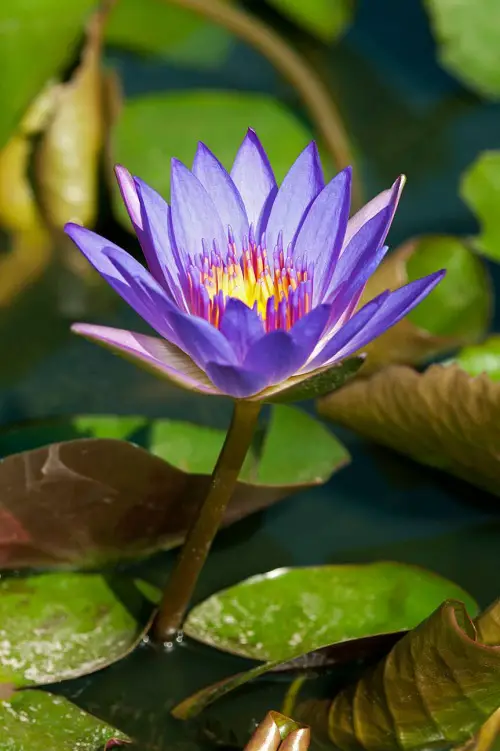What’s the hidden meaning behind the ancient Blue Lotus Flower? Peel back the petals of this sacred bloom and make it a part of your home!
Blooming along the Nile, this sacred flower was a potent symbol among ancient Egyptian royalty and deities. Even found in the famed tomb of King Tutankhamun, it is treasured for its psychoactive blue blooms. Let’s uncover the meaning of the intriguing blue lotus flower!
Everything About the Blue Lotus Flower

Botanical Name: Nymphaea caerulea
Also known as the Sacred Blue Lily of the Nile, this aquatic perennial naturally grows in slow-moving waters of rivers, ponds, and lakes. Native to tropical Africa and Arabia, its blooms open up to morning rays and retire with the setting sun.
Forming a shimmery blue-green mantle over water bodies, this aquatic perennial can spread up to eight feet wide. In summer, star-shaped pastel blooms emerge on slender petioles from the centers of glossy, round leaves.
Let’s explore the spiritual and sacred meaning of this bloom and discover why it is a rich addition to your home.
Blue Lotus Flower Meaning

Its reverence in ancient Egypt, as seen through its imagery on ancient papyri and tomb walls, has much to do with the blue lotus’s life and daily cycle. Just as it unfurls its petals to greet the sun every morning, the flower symbolizes rebirth and renewal and the cycle of life and death.
According to Egyptian mythology, the world was fully dark and filled with water. Through this deep shadow emerged the blue lotus, spreading light and life throughout the universe. This recurring motif among Egyptian royalty and deities like Osiris and Ra may also imply how the blue lotus was a bridge to the divine and earthly realms.
In fact, Nefertum—the god of perfume and sweet scents—was born from the bud of a blue lotus bloom at the beginning of life. An aspect of Ra, or God of all Gods, he represents rebirth, transformation, and sweet, intoxicating fragrances—all characteristic of this precious bloom.
Additionally, the flower’s psychoactive qualities made it a popular traditional medicine to treat insomnia and anxiety disorders, and it was used in rituals thanks to its mild euphoric effects.
Today, you can find it in legal states as a dried plant material, often used in vapes and e-cigarettes. However, hallucinations are not the way of the modern world. So don’t go eating this flower, as it can cause nausea, rapid heartbeats, and other complications.
Growing the Blue Lotus

Finally, after all these stories, wouldn’t you want this magical ancient symbol to bless your home garden?
This aquatic plant grows well in USDA Zones 9-11. It needs warmth, at least six hours of full sun daily to thrive, and a water body to grow in. You can build a homemade pond or even place a wide enough container in a sunny spot. Plant the blue lotus in nutrient-rich loam soil and submerge the pot 12-18 inches deep in water.
Blue lotus is a heavy feeder, so ensure you fertilize regularly during the growing season. It thrives in warm, sunny climes. With the right setup, it can do wonders for uplifting the aura and appearance of your water garden.


